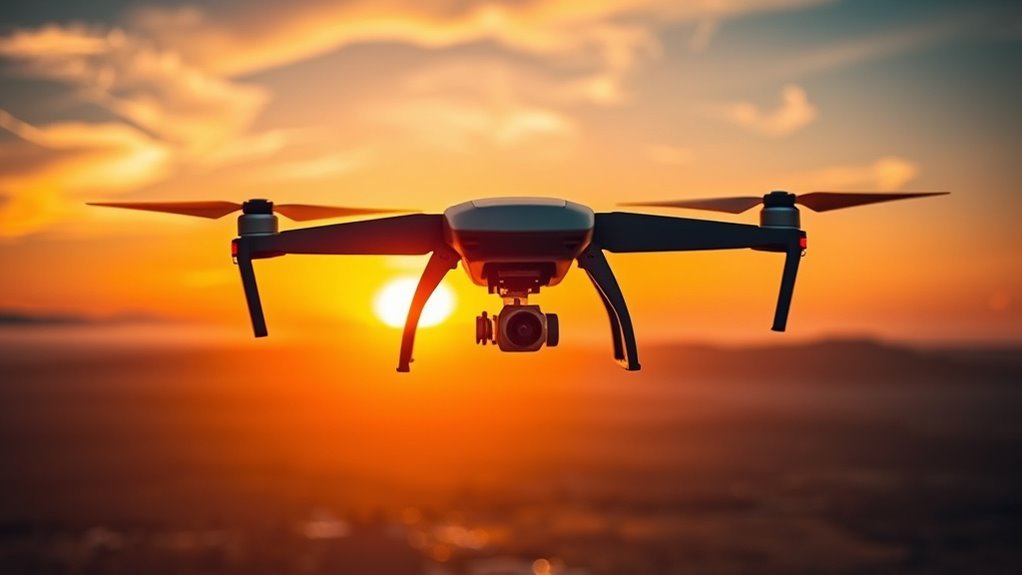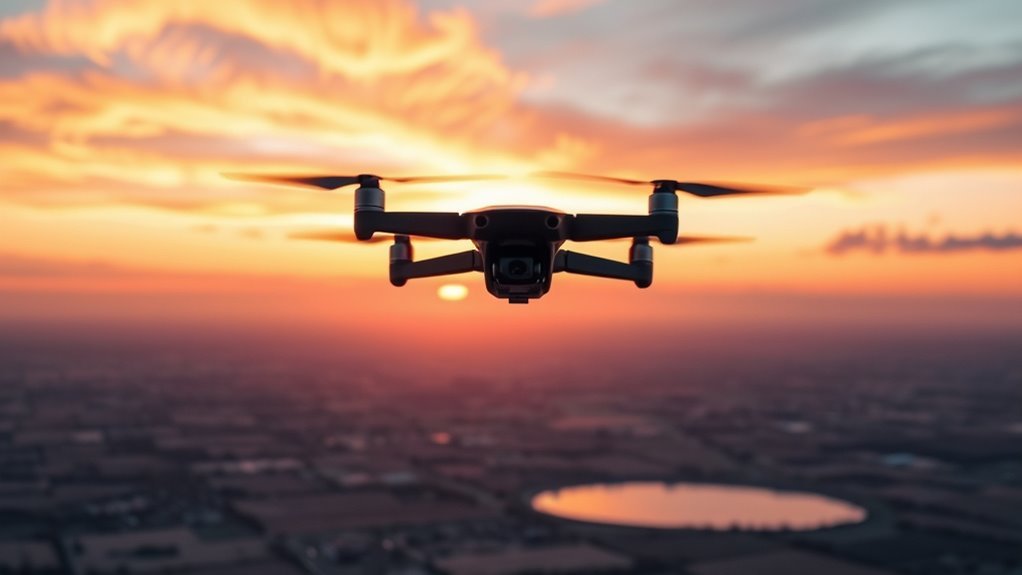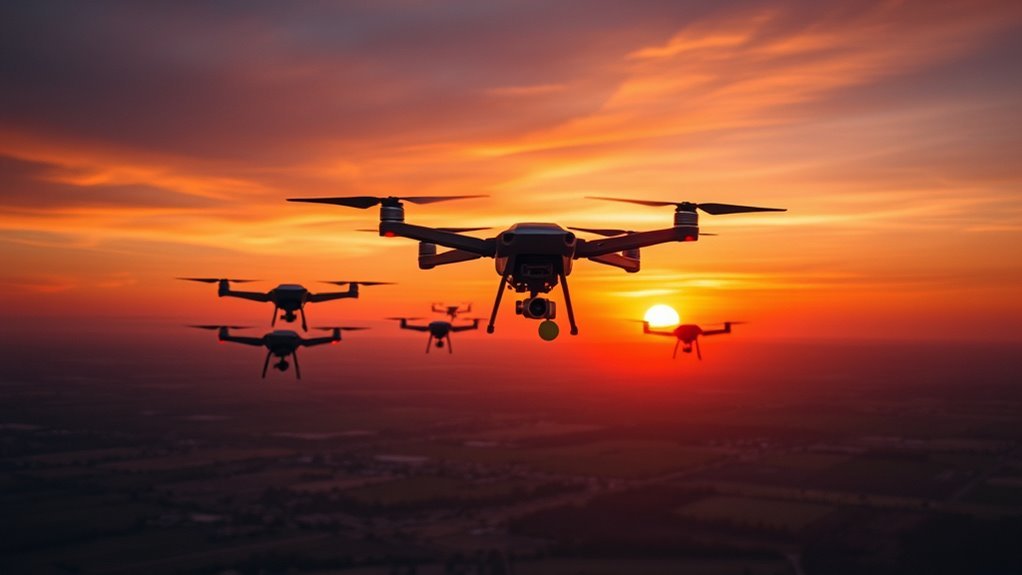Drones can fly anywhere from 5 to over 24 hours depending on the type and conditions. Consumer drones usually last 20 to 30 minutes, while commercial models can reach up to 60 minutes. Factors like battery capacity, weight, and environmental conditions greatly affect flight times. Heavy payloads, high winds, and temperature variations can drain batteries faster. Understanding these dynamics will enhance your drone performance. Discover how you can optimize your drone’s flight durations effectively.
Understanding Drone Battery Life

How do you guarantee peak performance from your drone’s battery? It starts with effective battery maintenance. Regularly inspect your battery for signs of wear and tear, ensuring connections remain clean and secure. Implementing proper charging techniques is essential; avoid overcharging or letting it discharge completely. Instead, aim to charge your battery to about 80% for ideal longevity. Store your drone battery in a cool, dry place, ideally at a partial charge, to prevent degradation. Temperature fluctuations can diminish battery life, so keep it away from extreme conditions. By following these guidelines, you can maximize efficiency and freedom in your drone’s operations, ensuring that it performs at its best whenever you’re ready to take to the skies. Moreover, understanding drone integration efficiency can further enhance your drone’s operational capabilities and longevity. For instance, drones like the DJI Mavic 3 Pro offer impressive flight times, showcasing the importance of battery management in optimizing performance.
Types of Drones and Their Flight Durations

Battery maintenance plays a significant role in determining the overall performance of various drone types, which directly influences their flight durations. Consumer drones typically offer flight times between 20 to 30 minutes, ideal for hobbyists and photographers. The DJI Air 3S can achieve up to 46 minutes of flight time, showcasing advancements in battery performance. Racing drones, designed for speed and agility, often have shorter flight durations, averaging around 5 to 10 minutes due to their high power demands. Commercial drones, utilized for tasks like surveying and delivery, can achieve 30 to 60 minutes of flight time, depending on payload capacity and battery efficiency. Military drones, engineered for endurance and reconnaissance, can fly for several hours, with some models exceeding 24 hours, reflecting their advanced technology and mission-specific designs. Understanding these distinctions helps you choose the right drone for your needs. Additionally, commercial drones like the Amazon MK30 can achieve up to 60 minutes of flight time per charge, showcasing advancements in energy efficiency.
Factors Affecting Flight Time

While various drone types offer different flight durations, several essential factors greatly influence actual flight time. Battery capacity is paramount; higher capacity batteries typically provide longer flight times. However, this isn’t the whole story. Flight efficiency also plays a vital role. Drones that are aerodynamically designed and equipped with energy-efficient motors can maximize the energy extracted from their batteries, extending flight duration. Environmental conditions, such as wind speed and temperature, can also affect efficiency, leading to increased power consumption. Payload weight is another important consideration—heavier loads drain batteries faster, reducing flight time. Understanding these factors allows you to optimize your drone’s performance, ensuring you get the most out of each flight. Notably, battery capacity impacts not only flight time but also the drone’s overall operational independence and effectiveness in various conditions. Furthermore, payload weight can significantly strain propulsion systems, emphasizing the need for careful load management to maintain stability and safety during flight.
Average Flight Times by Drone Type
Different types of drones exhibit varying average flight times, considerably influenced by their design and intended use. Understanding these differences can help you choose the right drone for your needs.
Different drones offer varied flight times, shaped by their design and purpose, aiding your choice for optimal performance.
- Drone Racing: Typically lasts around 5-10 minutes due to high-speed demands.
- Aerial Photography: Often boasts flight times of 20-30 minutes, designed for stability and payload capacity.
- Consumer Drones: Average about 15-25 minutes, striking a balance between performance and usability.
- Commercial Drones: Can achieve 30-60 minutes, tailored for extended operations and heavy lifting, with models like the Puma LE offering exceptional endurance of up to 3.5 hours.
- Toy Drones: Usually fly for about 5-15 minutes, meant for casual use.
Selecting a drone based on these flight times is essential for maximizing your aerial experience, whether for racing or capturing stunning photographs. Additionally, understanding the typical lifespan of drones can help you make informed decisions regarding maintenance and longevity.
Tips for Extending Drone Flight Times
To maximize your drone’s flight time, you’ll need to optimize battery usage and reduce the weight load. Efficient battery management involves monitoring usage patterns and minimizing unnecessary power draw. Additionally, every ounce counts; stripping excess weight can greatly enhance flight duration. Implementing energy management techniques can further extend your drone’s airtime by ensuring that battery power is used efficiently throughout the flight. Furthermore, understanding battery life can help you make informed decisions about flight planning and energy consumption strategies.
Optimize Battery Usage
As you seek to maximize your drone’s flight duration, understanding how to optimize battery usage becomes essential. Effective battery management can greatly extend your flight times, allowing you to explore more freely. Here are key strategies to take into account:
- Regular battery maintenance: Keep connections clean and check for damage.
- Optimal charging: Use the correct charger and avoid overcharging.
- Power management settings: Utilize your drone’s built-in features to conserve energy.
- Flight mode selection: Choose efficient modes for different tasks.
- Temperature considerations: Avoid extreme temperatures that can affect battery performance.
Reduce Weight Load
While optimizing battery usage is a key factor in extending flight times, reducing the weight load on your drone can also make a significant impact. Start by evaluating the weight distribution of your equipment and payload. Every gram counts, so aim for payload optimization by selecting lighter materials and minimizing unnecessary accessories. Consider using high-strength, lightweight components, which can maintain structural integrity without adding excess weight. Additionally, distribute the load evenly to enhance stability and efficiency during flight. By carefully balancing weight, you’ll reduce energy consumption and improve overall performance. Ultimately, lighter drones can achieve longer flight durations, providing you with the freedom to explore more extensive areas without the constant concern of battery depletion.
Environmental Conditions Impacting Flight Duration
Environmental conditions greatly influence drone flight durations, as factors such as wind speed, temperature, and humidity can affect battery performance and aerodynamic efficiency. Understanding these conditions is essential for maximizing your drone’s capabilities.
Environmental factors like wind and temperature significantly impact drone flight times and performance efficiency.
- Weather conditions: High winds can lead to increased energy consumption, impacting flight time and overall mission effectiveness.
- Altitude effects: Higher altitudes may reduce air density, impacting lift.
- Temperature impact: Extreme temperatures can degrade battery performance.
- Humidity levels: Elevated humidity can affect electronic components and weight.
- Terrain variations: Flying over rugged terrain can increase drag and resistance.
Additionally, weather conditions such as gusty winds can cause erratic movements, requiring stabilization mechanisms that consume extra power.
Weight Considerations for Optimal Flight
Understanding weight considerations is essential for achieving ideal drone flight performance, since excess weight can greatly reduce flight duration and efficiency. To maximize your drone’s capabilities, focus on optimal weight distribution. This means evenly balancing payloads and ensuring that your drone materials are lightweight yet durable. Using advanced materials like carbon fiber or lightweight plastics can greatly enhance performance. Keep in mind that every additional gram affects battery life; even small adjustments can lead to notable improvements in flight time. Additionally, payload weight is a critical factor that influences thrust requirements and overall energy consumption. Always assess the trade-off between necessary equipment and overall weight. By meticulously managing weight, you’ll reveal the potential for longer, more efficient flights, allowing you the freedom to explore greater distances and achieve more ambitious aerial tasks. Additionally, understanding flight time performance is crucial when selecting a drone, as it directly impacts your flying experience.
Innovations in Drone Battery Technology
As advancements in drone technology continue to accelerate, innovations in battery technology play a pivotal role in enhancing flight durations and overall performance. One of the most promising developments is the introduction of solid state batteries, which offer higher energy density and improved safety compared to traditional lithium-ion cells.
Here are key features driving these innovations:
- Increased energy efficiency for longer flights
- Reduced weight, allowing for more payload capacity
- Faster charging times, improving operational readiness
- Enhanced thermal stability for safer flights
- Longer lifespan, reducing replacement costs
These advancements not only extend flight durations but also empower you to explore new possibilities in drone applications, making your experience more versatile and fulfilling. Additionally, the integration of advanced battery optimization techniques is crucial for maximizing power management and ensuring prolonged flight times. The Dji Mini 2, for example, achieves up to 31 minutes of flight time under ideal conditions, showcasing the importance of battery technology in extending exploration capabilities.
Future Trends in Drone Flight Durations
While the current advancements in battery technology have set a strong foundation, the future of drone flight durations is poised for even more dramatic transformations. Expect breakthroughs in autonomous flight capabilities that leverage artificial intelligence to optimize flight paths and reduce energy consumption. These innovations will enhance energy efficiency, allowing drones to cover more extensive areas without frequent recharging. Additionally, emerging battery chemistries, such as solid-state and solar-integrated systems, promise to greatly extend flight times. As manufacturers focus on lightweight materials and enhanced aerodynamics, you’ll see drones capable of sustained flights in various environments. Ultimately, these trends will redefine your perception of drone flight, granting unprecedented freedom in applications ranging from delivery services to environmental monitoring.
Frequently Asked Questions
Can Drone Flight Time Be Extended With Aftermarket Batteries?
If you’re seeking to soar higher and longer, aftermarket battery types can indeed extend your drone’s flight time. However, consider that battery capacity impacts performance; a balance between weight and power is essential for ideal results.
How Do Flying Styles Affect Drone Flight Duration?
Your flying style greatly impacts drone flight duration. Higher altitudes require more power, while aggressive flight maneuvers drain batteries faster. Smooth, controlled movements can enhance efficiency, maximizing your drone’s time in the air.
What Maintenance Affects Drone Battery Performance and Flight Time?
When it comes to drone performance, you’ve got to keep your ducks in a row. Proper battery care and propeller upkeep can greatly enhance flight time, ensuring you maximize your aerial adventures and enjoy ultimate freedom.
Are There Regulations Limiting Drone Flight Durations?
Yes, there are flight regulations that may limit your drone’s flight durations, especially if certifications are required. It’s essential to understand these rules to guarantee compliance while maximizing your operational freedom and efficiency.
Do Different Weather Conditions Affect Battery Efficiency?
Imagine a kite soaring, tethered by weather’s whims. Wind resistance can sap your drone’s strength, while temperature impact affects battery efficiency. So, yes, different conditions can greatly influence how long your drone stays aloft.

